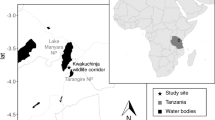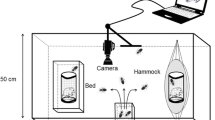Abstract
The primary locus of contact between free-living yellow baboons (Papio cynocephalus) in the Amboseli National Park of Kenya and the infective stages of their intestinal parasites is believed to be soil beneath sleeping trees contaminated by the baboons' own fecal emissions. In this report, we present evidence both that infective ova and larvae of intestinal parasites are found at very high densities in the soil beneath sleeping groves and that Amboseli baboons substantially reduce their contact with this reservoir of parasites by alternating periods of a few consecutive nights' use of any particular grove with much longer periods of avoidance of that grove. Although many factors other than the presence of parasite larvae also influence choice of sleeping groves, we propose as a working hypothesis that the temporal pattern of sleeping grove alternation shown by Amboseli baboons reflects a subtle behavioral strategy for parasite avoidance.
Similar content being viewed by others
References
Altmann, J., S. A. Altmann, G. Hausfater &S. A. McCuskey, 1977. Life history of yellow baboons: Physical development, reproductive parameters and infant mortality.Primates, 18: 315–330.
Altmann, S. A. &J. Altmann, 1970.Baboon Ecology. Univ. of Chicago Press, Chicago.
Cabel, R. M., 1960An Illustrated Laboratory Manual of Parasitology. Burgess Pub. Co., Minneapolis.
Cohen, S. &E. H. Sadun (eds.), 1976.Immunology of Parasite Infection. Blackwell Scientific Pub., Oxford.
Flynn, R. J., 1973.Parasites of Laboratory Animals. Iowa State Univ. Press, Ames.
Freeland, W. J., 1976. Pathogens and the evolution of primate sociality.Biotropica, 8: 12–24.
Garcia, L. S. &L. R. Ash, 1975.Diagnostic Parasitology. C. V. Mosby Co., St. Louis.
Georgi, J. R., 1974.Parasitology for Veterinarians. W. B. Saunders & Co., Philadelphia.
Halffter, G. &E. G. Matthews, 1966. The natural history of dung beetles of the subfamily Scarabaeinae (Coleoptera, Scarabaeidae).Folia Entomol. Mex., 12–14: 1–312.
Hausfater, G., 1975.Dominance and Reporduction in Baboons: A Quantitative Analysis. Contributions to Primatology, Vol. 7, S. Karger, Basel.
———— &H. Bearce, 1976. Acacia tree exudates: their composition and use as a food source by baboons.E. Afr. Wildl. J., 14: 241–243.
———— &D. F. Watson, 1976. Social and reproductive correlates of parasite ova emissions by baboons.Nature, 262: 688–689.
————,J. A. Altmann &S. A. Altmann, 1979.Guidebook for the Long-term Monitoring of Amboseli Baboons and Their Habitat. Published by the authors, Chicago.
Kuntz, R. E. &J. A. Moore, 1973. Commensals and parasites of African baboons (Papio cynocephalus L. 1766) captured in Rift Valley Province of central Kenya.J. Med. Parasitol., 2: 236–241.
Lysek, C. H., 1966. On destruction ofAscaris eggs in the soil. In:Proceedings of the First International Congress of Parasitology (Rome, 21–26 September, 1964),A. Corradetti (ed.), Pergamon Press, Oxford, pp. 788–789.
Miller, A. &E. Chi-Rodriguez, 1961. The fate of helminth eggs and protozoan cysts in human feces ingested by dung beetles (Coleoptera: Scarabaeidae).Amer. J. Trop. Med. Hyg., 10: 748–754.
Ollerenshaw, C. B. &L. P. Smith, 1969. Meterological factors and forecasts of helminthic disease.Advanc. Parasitol., 7: 283–323.
Olsen, O. W., 1974.Animal Parasites, Their Life Cycles and Ecology. Univ. Park Press, Baltimore.
Post, D. G., G. Hausfater &S. A. McCuskey, 1980. Feeding behavior of yellow baboons: Relationship to age, gender and dominance rank.Folia Primatol., 34: 170–195.
Schaeffer, R. & D. Njai, 1978. Water and health-Amboseli Masai. Paper read at Civil Engineers' Conference on Tropical Water-Related Diseases, December 11–15, London.
Sheldon, A. J., 1937. Some experimental studies inStrongyloides ratti.Amer. J. Hyg., 25: 39–52.
Soulsby, E. J., 1968.Helminths, Arthropods and Protozoan of Domesticated Animals. Williams & Wilkins Co., Baltimore, pp. 178–222.
Stelzner, J. K. &G. Hausfater, 1980. Behavioral aspects of thermoregulation in yellow baboons.Amer. Zoologist, 20: 763.
Western, D., 1972. The Structure, dynamics and changes of the Amboseli ecosystem. Unpub. doctoral dissertation, Univ. of Nairobi, Nairobi, Kenya.
———— &C. van Praet, 1973. Cyclical changes in the habitat and climate of an African ecosystem.Nature, 241: 104–106.
Author information
Authors and Affiliations
About this article
Cite this article
Hausfater, G., Meade, B.J. Alternation of sleeping groves by yellow baboons (Papio cynocephalus) as a strategy for parasite avoidance. Primates 23, 287–297 (1982). https://doi.org/10.1007/BF02381167
Received:
Accepted:
Issue Date:
DOI: https://doi.org/10.1007/BF02381167




